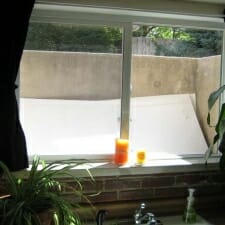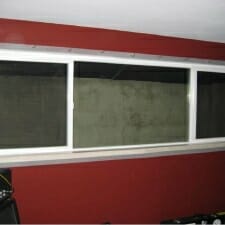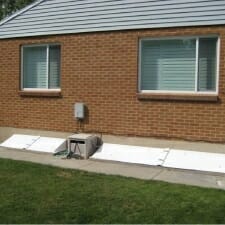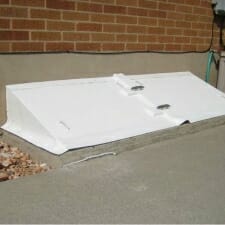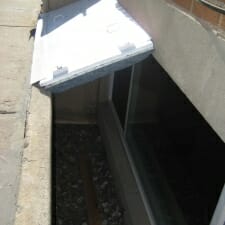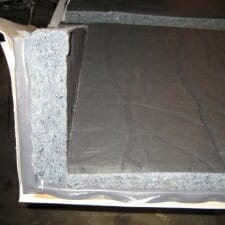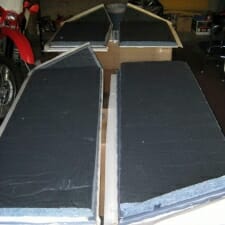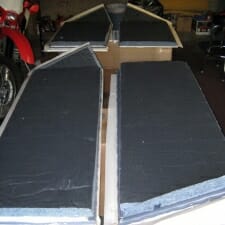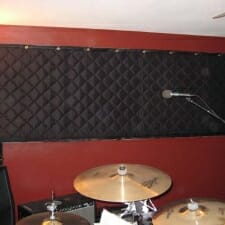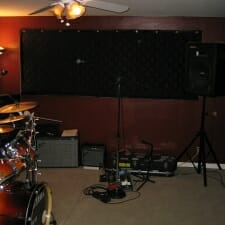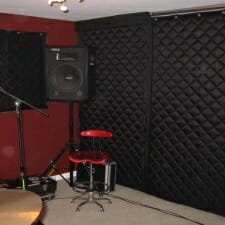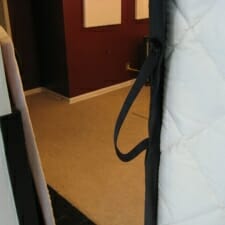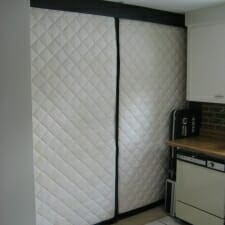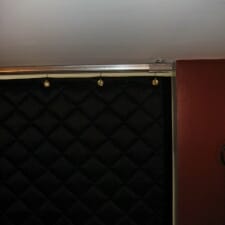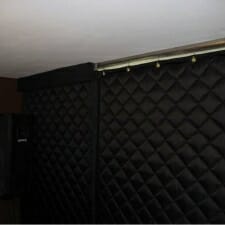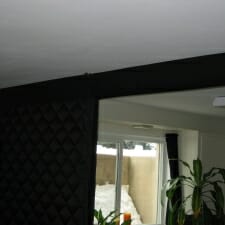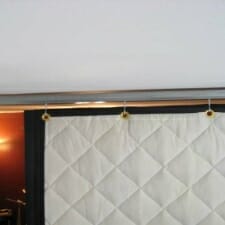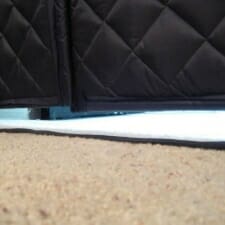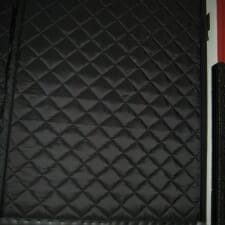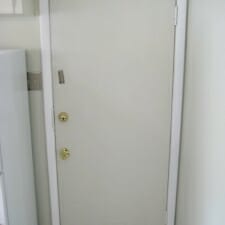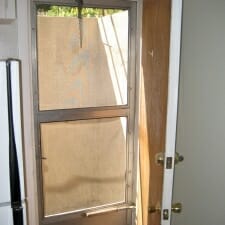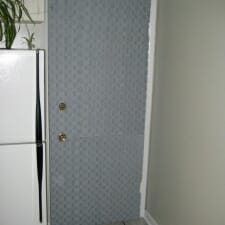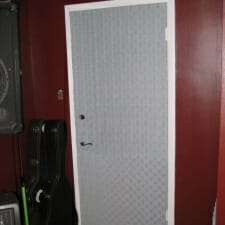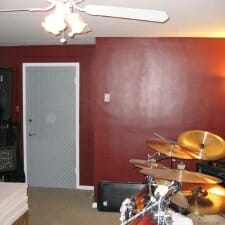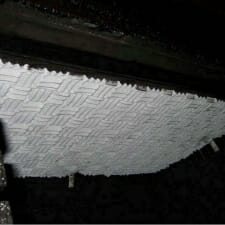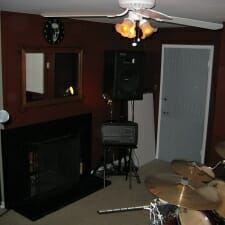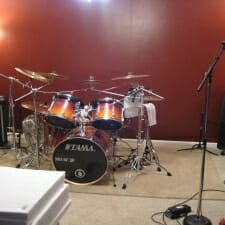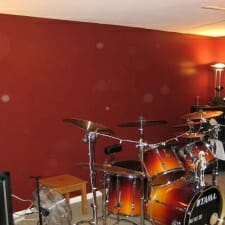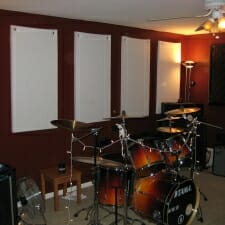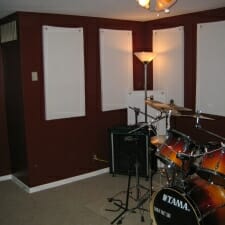Toby Studio Testimonial
Toby’s Home practice room / Studio
I began working Withy Toby back in April of 2008. He called our company looking for a solution to his problem. Toby is in a band and the band uses his house to practice. The concern was to contain the sound being made by the band from disturbing the neighbors. It was clear to Toby that blocking sound from being heard in the rest of the house was going to be EXTREMELY challenging, if not impossible. So, we began the discussion.
The two rooms that the band used as a practice area consisted of a living area and a separated “mother-in-law” kitchen. On the far wall of the kitchen there is a door leading out to a cement stairway that lead up to ground level. On the wall of the living area that faced the neighbor’s property was a large egress window so that the living area could be used as a bedroom and to bring natural light into the room. Being that the band had already been using this room for a while, Toby knew the areas that needed to be treated, so we focused on those areas first.
The first thing that we discussed was the large egress window. Before the acoustical treatment, this was clearly the weakest link in the wall assembly. Toby and I talked about a few treatments and one of the concerns for the window barrier was the ability to fully remove the thing to be able to turn the room back into a livable space when it was needed. It was decided that our Quilted Acoustical Curtain was a good choice because it could be made to size, had a black facing, and although it is a heavy, limp product, it could be mounted on hooks above the window and allowed to be draped down, over the window. We made a panel that had a 6” overlap on all sides of the window to eliminate any sound leaks.
Due to the fact that Toby’s number one concern was to NOT disturb the neighbors, we also discussed making a noise barrier that could be installed when the band was going to play. If you look at the concrete surround that makes up the window well, this area would basically act like an amplifier for any sound that escaped thru the quilted blanket and the window. Toby stated that he was able and willing to come up with a barrier for the outside of the house and we talked about lining it with an acoustically absorbent product which turned out to be our 2” thick Quiet Liner. This is a soft, light cotton that comes in a roll. It was adhered to the back of the structural boards that were built specifically for each window with a construction adhesive. I explained that one very important thing to keep in mind during the fabrication of these window covers was to make them as air tight as possible. A 5% air gap in the overall window cover would leak 90% of the sound out of the window well. The reason why it was decided to put the cotton on the window side of the covers was to introduce some absorption inside of the window well, so that any sound escaping did not reflect around and around and eventually make its way out. When the band is not practicing, these are stored out of the elements.
Now that the huge hole in the wall had been addressed, we began discussing the kitchen. The concern here was that the sound being made by the band would escape thru the kitchen window as well as the door that lead to the concrete stairwell. Toby inquired about making a movable sound barrier that could be opened and closed as needed. We decided to fabricate a two-piece curtain system on an overhead roller-hook system kind of like a patio door. The panels would be joined together by one center, vertical Velcro seam. This would allow for access to the kitchen when one of the members needed to get a beer or when in-laws were staying in town and wanted to use the kitchen. After these curtains were installed, it was discovered that there were two small problems. The air gap between the top of the curtain and the track as well as the air gap from the bottom of the curtain and the floor. I sent a few small pieces of our Mass Loaded Vinyl noise barrier as well as a very heavy duty stapler and staples that would connect the vinyl strips to the bottom of the curtain like a floor sweep. Toby also used a very aggressive adhesive and glued strips of the vinyl to the track so that it hung down a few inches and eliminated the air gap overhead.
After the curtain was installed, there was still a little too much sound making it’s way thru the kitchen door leading outside. It was decided to adhere some of our Melamine Composite panels to the door. These panels not only absorb echo, but have a center layer of the Mass Loaded Vinyl which is a noise barrier. The vinyl is then backed with a second layer of foam which allows the vinyl to move and vibrate slightly as the sound energy hits it. After these were installed, Toby reported a fairly significant reduction in the sound that was audible out of that side of the house.
Because of the extensive acoustical treatment and effort that was going into keeping the neighbors happy, we also talked about the sound not only within the room but to hopefully, minimally reduce the amount of noise that made it’s way to the rest of the house. The band practice room had two “weak links” that we decided to attack as well. The door from the hallway leading into the room as well as the fire place. Before we started, we both knew that blocking the sound from going into the fire place and up the chimney were going to be a steep uphill battle. But, it was decided that the same melamine panels that were used on the kitchen door were to be installed into the top of the fire place as well as onto the back of the door for the room. These helped as much as possible, but a fairly significant amount of transmission still exists. It would take quite a bit of work as well as making the fire place totally and permanently non-functional to reduce it further. Sometimes all you can do is all you can do.
With a full band practicing in a small room made up of mostly hard, reflective surfaces, it was time to find a very cost effective way to control some of the echo and reverberation of the room. The “sound proofing” was done but the sound quality needed to be improved. By this point, Toby had already exceeded the budget that he had set aside for the project, but he felt that he couldn’t go this far and not get some absorptive panels into the room. Keeping in mind that the treatment that he chose could not be a permanent, glue-on type of product. With this in mind, I quickly suggested some of our Echo Eliminator panels which were on our discountsoundproofing.com website. These were 2” panels made from white cotton. Our shipping guys had already pounded two grommets into the top corners of each, but had used the wrong grommet color – so we were liquidating them. These panels could be hung very easily on hooks or nails sticking out of the wall and when they were not needed, be taken down and stored. It seemed like the perfect solution.
The text below is the bullet point style feedback that Toby sent me after using the room for a while. Maybe he can print off the article and put it in a frame and show his wife how famous he is. If you are in the northern Utah area and are looking for a band, let me know, I’ve got em. These guys rock.
Problem before the sound-proofing:
Courtesy to neighbors, really. Neighbors house to the south of my house and the side where the large basement windows are is approximately 60-70’.
Also, wanted to try to consolidate the sound to the studio room as much as possible to dampen the noise within the house. I realize this would have taken a lot more design, cost, and sound-proofing to do this but it was also a factor in the sound-proofing project.
We’re a loud surf rock and roll band with a lot of wattage flowing when we play, hence all frequency ranges seem to find their way through the cracks, windows, and doorways.
Two large windows outside the studio room and basement kitchen provided a “path of least resistance” for the sound to escape to the outside.
Large cement window wells create an “amphitheater” effect and amply the sound when passing through the windows to the outside.
I didn’t want to do anything too permanent that would change the character of the living room and to maintain resale value. So the sound proofing needed to be something that could be taken down easily depending on the situation (i.e., keeping it a livable space, allowing light and outside air into the rooms when we’re not playing, etc.)
Installation:
Had original plan but no idea what materials would be the best fit for what I wanted to do while considering cost. This is where you came in!
This was kind of a design build project to take one problem area at a time.
Measured out all the areas that needed material covering to help keep sound w/in the room – such as the flue to the fire place, doors, windows, window wells, area between kitchen and studio room.
Consulted with you at ASI on what material would work best given the situation. Took photos so you could see what I was looking at to help better determine which materials, design would work best.
Install was fairly easy.
Tight seal is key and was considerably noticeable where there where cracks underneath the doors prior to the install.
Window well coverings took the longest b/c they needed to conform to uneven concrete settling, be water proof (well, resistant anyway), sound proof, and be able to be removed and stored w/in the window well as easily as possible.
After sound-proofing:
Can stand at fence line between our house and neighbors house and barely hear the music. Birds and crickets chirping are louder than the faint sound you hear coming from the house.
Also, very quite at the front of the house when standing outside the garage, which comes from the basement on the opposite side of the basement windows in the studio.
Quilted curtain, new window, window well cover combo seems to be the most effective at blocking the sound from going outside.
Still considerably loud above the studio room in the house but that was a given and I realized I would’ve had to spend a lot more $ and have a more permanent design to try to prevent that. The sound seems to escape upstairs through a return vent in the corner of the upstairs living room. Considering making a removable panel to go over it when we play, but then need to turn of the heat or a/c when we play.
The divider wall between the studio and basement kitchen helps take away the sharpness of the tones and dampens the sound before it hits the hard tile and wood cabinets which reflect the sound waves.
The proofing on the kitchen door that leads to the outside really helps prevent the sound from escaping out to the stair well.
The echo eliminator panels really keep the sound tight and pure within the room.
Still have to coordinate with my wife on when we practice so that she isn’t trying to sleep or study while we play!
Probably more than you were looking for but take or leave what you want.
Let me know if you want something more specific and I can provide that. Also, let me know when it’s up so I can see it!
Thanks and hope you’re 2009 is going well!
Toby
If you have any questions or need any information about any of the products or applications discussed in this article, please feel free to contact me. I would be happy to do my best to help you. Ted Weidman, Acoustical Surfaces, Inc. 123 Columbia Court North, Suite 100 Chaska, MN 55375 p. 800.527.6253 f. 952.448.5300 or e. [email protected]



